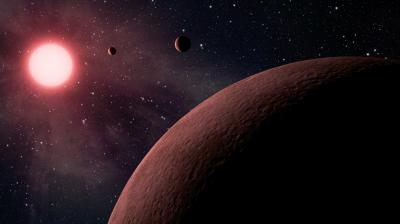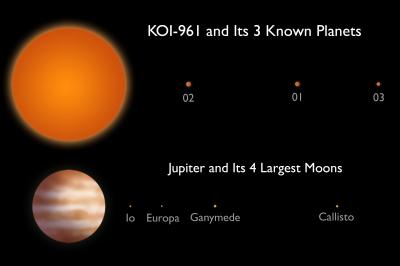A team of astronomers led by scientists at the California Institute of Technology (Caltech) has discovered the three smallest confirmed planets ever detected outside our solar system. The three planets, which all orbit a single star, are smaller than Earth and appear to be rocky with a solid surface. Until now, astronomers have found at most only four other rocky planets, also called terrestrial planets, around other stars.
The trio of new planets is too close to the central star to be in its habitable zone—the ring-shaped region around a star where the temperature is mild enough for liquid water, and possibly life, to exist. But the planets are the first rocky ones to be found orbiting a type of dim, small star called a red dwarf, the most common kind in the Milky Way. Their existence suggests that the galaxy could be teeming with similarly rocky planets—and that there's a good chance that many are in the habitable zone.
The red dwarf, called KOI-961, was first flagged as a potential planetary system by the Kepler mission, a space telescope that looks for planets around sunlike stars by scanning the sky for stars that periodically dip in brightness—the result of one or more planets passing in front of them. Although Kepler reported 900 potential planetary systems in February, only about 85 of those were red-dwarf systems. The fact that a relatively small sample of red dwarfs produced three terrestrial planets means that either the Caltech-led team was really lucky or, more likely, that these planets are commonly found around red dwarfs.
"When you combine that with the fact that these are some of the most numerous stars in the galaxy, you realize this type of system could be common," says Philip Muirhead, a postdoctoral scholar at Caltech. "There's no question that it's exciting." Muirhead is the lead author on the paper describing the discovery, which has been accepted by the Astrophysical Journal. The team will also present their results in two talks on January 11 at the meeting of the American Astronomical Society in Austin, Texas.
"Red dwarfs make up eight out of every ten stars in the galaxy," adds John Johnson, assistant professor of astronomy and one of the paper's coauthors. "That boosts the chances of other life being in the universe—that's the ultimate result here. If these planets are as common as they appear—and because red dwarfs themselves are so common—then the whole galaxy must be just swarming with little habitable planets around faint red dwarfs."
This report comes just a few weeks after the Kepler team announced it had detected two rocky planets around a sunlike star—Kepler-20e and Kepler-20f—the first Earth-sized planets ever found and the smallest known at the time. In January 2011, the Kepler team reported the discovery of the first unequivocally rocky planet around another star, Kepler-10b. Another planet—Corot-7b, which was found in 2009—could also be a rocky planet.

This artist's concept depicts an itsy bitsy planetary system -- so compact, in fact, that it's more like Jupiter and its moons than a star and its planets. Astronomers using data from NASA's Kepler mission and ground-based telescopes recently confirmed that the system, called KOI-961, hosts the three smallest exoplanets known so far to orbit a star other than our sun. An exoplanet is a planet that resides outside of our solar system. The star, which is located about 130 light-years away in the Cygnus constellation, is what's called a red dwarf. It's one-sixth the size of the sun, or just 70 percent bigger than Jupiter. The star is also cooler than our sun, and gives off more red light than yellow. The smallest of the three planets, called KOI-961.03, is actually located the farthest from the star, and is pictured in the foreground. This planet is about the same size as Mars, with a radius only 0.57 times that of Earth. The next planet to the upper right is KOI-961.01, which is 0.78 times the radius of Earth. The planet closest to the star is KOI-961.02, with a radius 0.73 times the Earth's. All three planets whip around the star in less than two days, with the closest planet taking less than half a day. Their close proximity to the star also means they are scorching hot, with temperatures ranging from 350 to 836 degrees Fahrenheit (176 to 447 degrees Celsius). The star's habitable zone, or the region where liquid water could exist, is located far beyond the planets. The ground-based observations contributing to these discoveries were made with the Palomar Observatory, near San Diego, Calif., and the W.M. Keck Observatory atop Mauna Kea in Hawaii.

This chart compares the smallest known exoplanets, or planets orbiting outside the solar system, to our own planets Mars and Earth. Astronomers using data from NASA's Kepler mission and ground-based telescopes recently discovered the three smallest exoplanets known to circle another star, called KOI-961.01, KOI-961.02 and KOI-961.03. The smallest of these, KOI-961.03, is about the size of Mars with a radius of only 0.57 times that of Earth. Not long ago, in Dec. of 2011, the Kepler team announced the discovery of Kepler-20e and Kepler-20f -- the first Earth-size planets ever found outside the solar system. All five of these small exoplanets have toasty orbits close to their stars, and do not lie in the more temperate habitable zone. The ground-based observations contributing to the KOI-961 discoveries were made with the Palomar Observatory, near San Diego, Calif., and the W.M. Keck Observatory atop Mauna Kea in Hawaii.

This artist's conception compares the KOI-961 planetary system to Jupiter and the largest four of its many moons. The KOI-961 planetary system hosts the three smallest planets known to orbit a star beyond our sun (called KOI-961.01, KOI-961.02 and KOI-961.03). The smallest of these planets, KOI-961.03, is about the same size as Mars. All three planets take less than two days to whip around their star. The planets were discovered using data from NASA's Kepler mission and ground-based telescopes. The KOI-961 star is a tiny "red dwarf," just one-sixth the size of our sun. This planetary system is the most compact detected to date, with a scale closer to Jupiter and its moons than another star system. The planet and moon orbits are drawn to the same scale. The sizes of the stars, planets and moons have been increased for visibility.
See the website for more details: http://www.eurekalert.org/pub_releases/2012-01/ciot-aft011112.php (SY)
